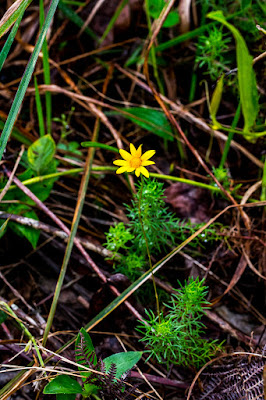The owner of a property overlooking the lower Umtamvuna River gorge and the Red Desert Nature Reserve asked whether it would still be a good idea to undertake a management burn of his grassland. We advised that it was now too late but agreed to assess the condition of his unburned grassland as well as a section that had been burned earlier. We met near the Red Desert Nature Reserve and drove along a steep farm track to reach the grassland. The grassland was wet after overnight drizzle so we all donned waterproof gear and set off.
Very soon we started seeing flowers in a mowed track and in the adjacent grassland, despite the obscuring effect of the tall grass. Here we found
Hewittia malabarica, Freesia laxa, Ledebouria petiolata, Gomphocarpus physocarpus, Dierma igneum and some well disguised
Acrolophia coclearis. Protruding well above the dry grass were several
Drimia echinostachya, a few
Eriosema salignum and
Selago tarachodes. Kohautia amatymbica waved their white flower clusters at the end of grass-like stalks
.
 |
| Hewittia malabarica |
 |
| Freesia laxa |
 |
| Ledebouria petiolata |
 |
| Gomphocarpus physocarpus |
 |
| Acrolophia cochlearis |
 |
| Dierama igneum |
 |
| Drimia echinostachya |
 |
| Eriosema salignum |
 |
| Selago tarachodes |
 |
| Kohautia amatymbica |
However it was only when we reached the burned section that we saw the full botanical richness of this grassland area.
Dyschoriste burchellii clustered around some early
Helichrysum pannosum shoots. There was a tangle of
Geranium flanaganii and several
Eriosema umtamvunense as well as bold
Chamaecrista comosa flowers. Splashes of white clusters of
Callilepis laureola overshadowed some discrete
Acalypha wilmsii.
 |
| Dyschoriste burchellii |
 |
| Geranium flanaganii |
 |
| Eriosema umtamvunense |
 |
| Chamaecrista comosa |
 |
| Callilepis laureola |
 |
| Acalypha wilmsii |
We found
Argyrolobium rotundifolium with its yellow-turning-orange flowers,
Ajuga ophridis, and three
Berkheya species
: B. setifera, B. speciosa, and
B. umbellata. There were some
Commelina africana, Convolvulus natalensis, Cyanotis speciosa and
Eriosema kraussianum.
 |
| Argyrolobium rotundifolium |
 |
| Ajuga ophridis |
 |
| Berkheya setifera |
 |
| Berkheya speciosa |
 |
| Berkheya umbellata |
 |
| Commelina africana |
 |
| Convolvulus natalensis |
 |
| Cyanotis speciosa |
 |
| Eriosema kraussianum |
Gladiolus longicollis bobbed their heads in the breeze -- most of these flowers were boldly marked, in contrast to the plain white we normally see. There were several
Hilliardiella hirsuta with their large purple inflorescenses. We found
Ipomoea crassipes and despite its attractive markings, a well-camouflaged mantis on a
Schizoglossum atropurpureum subsp. virens.
 |
| Gladiolus longicollis |
 |
| Hilliardiella hirsuta |
 |
| Ipomoea crassipes |
 |
| Well-camouflaged mantis |
Clustered near some rocks was
Plectrnthus hadiensis, Polygala myrtifolia Psychotria capensis, and
Psoralea arborea. Out in the open we found several
Ruellia cordata, Scabiosa columbaria and
Ornithogalum saundersiae.
We also found the first Sisyrantus imberbis of the season and a few of the short spur form of Eulophia parviflora.
 |
| Sisyranthus imberbis |
 |
| Eulophia parviflora (short spur) |
Participants; Alf H, Anne S, Dorothy M, Gail B-W, Graham G, Kate G, Maggie A, Tracy T.











































No comments:
Post a Comment